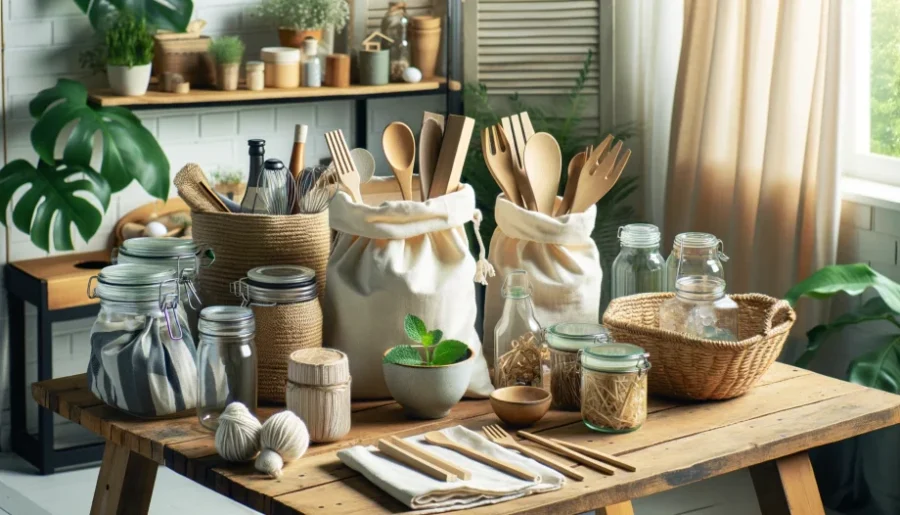
Discover practical tips for reducing household waste and embrace a greener lifestyle! Learn easy swaps and habits for a cleaner, eco-friendly home.
Tips for Reducing Household Waste
Key Takeaways:
- Tips for Reducing Household Waste include using reusable bags, containers, and water bottles; composting food scraps; buying in bulk to reduce packaging; and properly recycling.
- Small changes in daily habits can lead to significant waste reduction and a more sustainable lifestyle.
Looking for practical tips for reducing household waste? You’re in the right place!
Join us as we explore simple yet effective ways to minimize waste, make sustainable choices, and transform your home into a haven of eco-friendliness.
Let’s embark on this journey to a cleaner, greener future together!
Practical Tips for Reducing Household Waste
Reducing household waste is not only good for the environment but can also simplify your life and save you money.
In this blog post, we’ll share practical tips to help you minimize waste in your home and contribute to a more sustainable future.
1. Rethink Your Shopping Habits
Transforming your shopping habits is a crucial step in reducing household waste.
By making mindful choices, you can significantly cut down on packaging and single-use items. Here’s how to start:
Buy in Bulk

- Reduce Packaging: Bulk purchases typically use less packaging compared to individually wrapped items.
- Save Money: Buying in bulk is often more cost-effective in the long run.
- Choose Wisely: Opt for staples like grains, legumes, and spices that you use regularly.
Bring Your Own Bags
- Reusable Bags: Carry reusable shopping bags for groceries and other items.
- Produce Bags: Use cloth or mesh bags for fruits and vegetables instead of plastic bags.
- Containers: Bring your own containers for bulk items and deli purchases to avoid disposable packaging.
Choose Products with Less Packaging
- Minimal Packaging: Look for products with minimal or no packaging, such as bar soap or loose produce.
- Recyclable Packaging: When packaging is unavoidable, choose options that are easily recyclable in your area.
- Avoid Single-Use Plastics: Steer clear of products with excessive plastic packaging, especially those that are not recyclable.
By rethinking your shopping habits and opting for bulk purchases, reusable containers, and products with less packaging, you can make a significant impact on reducing household waste.
Every small change adds up to a cleaner, more sustainable home.
2. Embrace Reusables
Incorporating reusable items into your daily routine is a powerful way to combat waste.
By choosing durable, long-lasting alternatives to disposable products, you can reduce your environmental footprint and promote a more sustainable lifestyle.
Here’s how to make the switch:
Swap Disposables for Reusables
- Water Bottles: Opt for a stainless steel or glass water bottle instead of buying plastic bottles.
- Coffee Cups: Bring your own reusable cup to coffee shops. Many offer discounts for doing so.
- Straws: Use metal or bamboo straws instead of plastic ones.
Use Cloth Instead of Paper
- Napkins: Replace paper napkins with cloth ones. They add a touch of elegance to meals and can be washed and reused.
- Towels: Use cloth towels for cleaning and drying hands instead of paper towels.
- Rags: Old t-shirts or towels can be cut into rags for cleaning, reducing the need for disposable wipes.
Embracing reusables is a simple yet effective step toward reducing household waste.
By making these swaps, you contribute to a cleaner environment and a more sustainable future.
3. Reduce Food Waste

Minimizing food waste is essential for a sustainable household. By planning meals, storing food properly, and composting scraps, you can reduce waste and save money.
These simple strategies can make a big difference in how much food you throw away.
Plan Your Meals
- Meal Planning: Plan your meals for the week and make a shopping list. This helps you buy only what you need and avoid impulse purchases.
- Portion Control: Cook the right amount of food to prevent leftovers from going to waste.
- Use Leftovers: Get creative with leftovers. Turn them into new meals, or freeze them for later.
Store Food Properly
- Fruits and Vegetables: Store them in the right conditions to extend their freshness. Some produce is best kept in the fridge, while others last longer at room temperature.
- Leftovers: Store leftovers in airtight containers and label them with the date. Consume them within a few days.
- Pantry Organization: Keep your pantry organized so you can easily see what you have and use items before they expire.
Compost Food Scraps
- Set Up a Compost Bin: Start composting at home to turn food scraps into nutrient-rich soil for your garden.
- What to Compost: Fruit and vegetable scraps, coffee grounds, eggshells, and yard trimmings are all compostable.
- Benefits of Composting: Composting reduces landfill waste and provides a natural fertilizer for your plants.
Reducing food waste is a key component of a zero-waste lifestyle.
By being mindful of how you plan, store, and dispose of food, you can make a positive impact on the environment and your budget.
4. Recycle and Upcycle
Recycling and upcycling are key components of reducing household waste.
By recycling materials like paper, glass, and metal, we can conserve resources and reduce pollution.
Upcycling, on the other hand, allows us to get creative and give new life to items that might otherwise be discarded.
Let’s explore how to make the most of these practices.
Recycle Properly
- Learn Local Guidelines: Different areas have different rules for recycling. Make sure you know what can and can’t be recycled in your community.
- Sort Your Waste: Separate your recyclables from your trash. This helps ensure that they are processed correctly.
- Clean Your Recyclables: Rinse out containers and remove any food residue. Clean recyclables are more likely to be recycled successfully.
Upcycle Items
- Repurpose with Purpose: Look for ways to reuse items in your home. Old jars can become storage containers, and worn-out clothing can be turned into cleaning rags or quilts.
- Get Crafty: Use your creativity to transform items. Upcycling projects can be a fun way to personalize your home and reduce waste.
- Share Your Ideas: Inspire others by sharing your upcycling projects on social media or in community groups.
Recycling and upcycling are powerful tools in our quest to reduce waste.
By embracing these practices, we can minimize our impact on the environment and inspire others to do the same.
5. Reduce Paper and Digital Waste
In our digital age, reducing paper and digital waste is more achievable than ever.
By going paperless and managing unwanted mail, we can significantly cut down on clutter and environmental impact.
Let’s dive into how we can make these changes in our daily lives.
Go Paperless
- Digital Documents: Opt for digital versions of bills, bank statements, and other documents. Many companies offer paperless options that are more convenient and eco-friendly.
- E-Books and Magazines: Consider using e-books and digital subscriptions for reading materials. This not only saves paper but also allows for easy access to a wide range of content.
- Note-Taking Apps: Use digital note-taking apps instead of paper notebooks for jotting down ideas and reminders.
Unsubscribe from Junk Mail
- Mailing Lists: Remove yourself from unnecessary mailing lists to reduce the amount of junk mail you receive. Many organizations offer online options to opt out of physical mailings.
- Catalogs and Advertisements: If you receive unwanted catalogs or ads, contact the sender to request removal from their distribution list.
- Email Subscriptions: Regularly review and unsubscribe from unwanted email newsletters and promotions to keep your digital inbox clutter-free.
Reducing paper and digital waste is a simple yet effective way to contribute to a more sustainable world.
By embracing digital alternatives and managing our mail, we can reduce our environmental footprint and enjoy a more organized life.
6. Make Eco-Friendly Cleaning Choices
Choosing eco-friendly cleaning products and methods is a crucial aspect of a sustainable household.
By using natural ingredients and being mindful of water usage, we can keep our homes clean while reducing our environmental impact.
Let’s explore some practical ways to make greener cleaning choices.
Use Natural Cleaning Products
- DIY Solutions: Create your own cleaning products using ingredients like vinegar, baking soda, and lemon. These natural ingredients are effective for many cleaning tasks and are safer for the environment.
- Eco-Friendly Brands: If DIY isn’t your style, opt for commercial cleaning products that are eco-friendly. Look for products with non-toxic, biodegradable ingredients and minimal packaging.
- Essential Oils: Add essential oils to your homemade cleaners for a natural fragrance and additional cleaning properties.
Reduce Water Usage
- Efficient Cleaning Methods: Use methods that require less water, such as using a damp cloth for wiping surfaces instead of rinsing with water.
- Water-Saving Devices: Install water-saving devices like low-flow faucets and showerheads to reduce water usage while cleaning.
- Reuse Water: Collect rainwater or reuse greywater for cleaning tasks that don’t require potable water.
Making eco-friendly cleaning choices not only benefits the environment but also ensures a healthier living space for you and your family.
By adopting these sustainable practices, we can contribute to a cleaner and greener planet.
Reducing Household Waste FAQs
Reducing household waste is a crucial step towards a more sustainable lifestyle.
Many people have questions about how to effectively reduce waste in their daily lives.
Here are some common questions and answers to help guide you on your waste reduction journey.
Q: How can I reduce waste in my daily routine?
A: Start by rethinking your shopping habits, such as buying in bulk and bringing your own bags.
Embrace reusable items like water bottles and cloth napkins. Plan your meals to avoid food waste, recycle properly, and find creative ways to upcycle items instead of discarding them.
Q: What are some tips for reducing waste at school?
A: Students and teachers can reduce waste by using school supplies made from recycled materials, packing waste-free lunches, and setting up composting programs. Making posters to remind students about recycling and composting can also be effective.
Q: How can I reduce waste at work?
A: In the office, go paperless whenever possible, use double-sided printing, and pay bills electronically.
Purchase recycled paper and keep a recycling bin near your desk. Encourage your coworkers to buy green products and help reduce waste.
Q: What community activities can help reduce waste?
A: Participate in local clean-up events, organize recycling drives, and set up community composting programs.
Holding donation picnics or creating drop-off sites for old electronics can also make a difference.
Q: How does reducing food waste benefit the environment?
A: Reducing food waste conserves resources, reduces environmental impacts like climate change and pollution, and creates green jobs.
Composting food scraps instead of sending them to landfills reduces methane emissions, a potent greenhouse gas.
Q: How can I prevent food waste as a private citizen?
A: Plan your meals, use leftovers, and choose products close to their expiration date when shopping for immediate consumption.
Small actions like these can lead to significant reductions in food waste, saving money and helping the environment.
Tips for Reducing Household Waste Conclusion
Embracing a sustainable lifestyle through practical tips for reducing household waste is a journey that benefits both the environment and our personal well-being.
By making small changes in our daily habits, we can collectively make a significant impact.
Read more: Mastering Zero-Waste Living: 7 Easy Tips and Tricks
Read about Zero-Waste Pet Care Practices
Here are some key takeaways and future steps to consider:
Reflect on Progress
- Celebrate Achievements: Acknowledge the positive changes you’ve made in reducing waste.
- Evaluate Challenges: Identify any obstacles you faced and consider ways to overcome them in the future.
Spread the Word
- Share Your Journey: Inspire others by sharing your experiences and tips for waste reduction.
- Community Involvement: Encourage friends, family, and community members to join you in your efforts to reduce waste.
Stay Informed
- Keep Learning: Stay updated on new ways to reduce waste and implement sustainable practices.
- Support Sustainable Initiatives: Advocate for policies and programs that promote waste reduction and environmental sustainability.
Looking Ahead
- Set New Goals: Continue to set and strive for new waste reduction goals.
- Embrace Innovation: Be open to trying new products and technologies that can help reduce waste.
Final Thoughts
In conclusion, reducing household waste is an ongoing process that requires dedication and creativity.
By following these practical tips and staying committed to our goals, we can contribute to a healthier planet and a more sustainable future.
Resources for Further Reading on Reducing Household Waste
Reducing household waste is a crucial step towards a more sustainable lifestyle.
To help you on this journey, we’ve compiled a list of authoritative articles that offer insights and practical tips for minimizing waste in your home:
- “Reducing Waste: What You Can Do” – US EPA
- Offers tips for reducing waste at school, work, and in the community, including buying recycled products and setting up composting programs.
- Read more
- “Preventing Wasted Food At Home” – US EPA
- Provides tips for shopping, storage, and cooking to prevent food waste, such as buying in bulk and properly storing fruits and vegetables.
- Read more
- “A Closer Look at Effective Intervention Methods to Reduce Household Solid Waste Generation in Japan” – Sustainability
- Discusses the impact of urbanization on municipal solid waste and explores awareness-raising projects aimed at reducing household solid waste.
- Read more
- “How to Reduce Waste: 21 Ideas for Zero Waste Living” – One Tree Planted
- Shares 21 easy zero-waste tips, such as buying staples in bulk, avoiding plastic bottles, and investing in cloth produce bags.
- Read more
- “Reducing Waste to Save Our Planet: It Starts with You” – WWF-Philippines
- Highlights the environmental impacts of food waste and plastic waste, and provides tips for reducing waste in daily life.
- Read more
- Read our article on Zero-Waste Principles and Practices: Comprehensive Guide
These resources cover various aspects of waste reduction, from food waste prevention to sustainable shopping practices.
Whether you’re new to the concept of zero-waste living or looking to deepen your commitment, these articles provide valuable insights and actionable steps to help you reduce household waste and live more sustainably.










